 As machine vision and imaging technology become more advanced, attention is being paid to data outside the ordinary visible spectrum. Visible light makes up only a tiny portion of the total spectrum, which can provide a tremendous amount of environmental information. Multispectral imaging seeks to expand users' knowledge of the surroundings by capturing image data across the electromagnetic spectrum.
As machine vision and imaging technology become more advanced, attention is being paid to data outside the ordinary visible spectrum. Visible light makes up only a tiny portion of the total spectrum, which can provide a tremendous amount of environmental information. Multispectral imaging seeks to expand users' knowledge of the surroundings by capturing image data across the electromagnetic spectrum.
Uses of Multispectral Imaging & Analysis
There are many ways to implement multispectral imaging, but it generally combines two to five spectral imaging bands – each representing relatively large bandwidth – into one system. Examples of industry applications include:
- Healthcare:
The earliest, most successful uses of MSI were initially in diagnostic medicine. Multispectral imaging allows healthcare providers to pinpoint the presence of diseases hard to identify through other means. Soon, MSI may be combined with nanotechnology to diagnose health issues at the level of individual cells.
- Aerospace:
In a time of environmental concern, MSI is found in technologies that monitor Earth’s well-being. NASA makes extensive use of MSI in its orbiting satellites – advanced imaging technology makes it easier to map the progress of disasters, observe weather patterns, and keep tabs on agriculture anywhere in the world.
- Military:
Today’s military deals with unconventional threats and must monitor enemies that often have an advantage on local terrain. Multispectral imaging has a host of military applications, from locating improvised explosives to uncovering enemy movements and even pinpointing the depth of hidden bunkers.
Once out of reach for all but the richest enterprises, multispectral imaging will soon enter the toolkits of a wider variety of industrial concerns worldwide. This offers tremendous opportunities for both industrial process improvement and expanding our fundamental knowledge.
